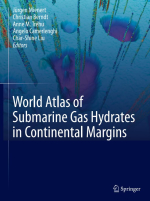Добрый день, Коллеги. Важное сообщение, просьба принять участие. Музей Ферсмана ищет помощь для реставрационных работ в помещении. Подробности по ссылке
World atlas of submarine gas hydrates in continental margins / Всемирный атлас подводных газовых гидратов на континентальных окраинах
The World Atlas of Submarine Gas Hydrates in Continental Margins is a comprehensive global compilation of geophysical evidence for the presence of natural gas hydrates in the seafloor. Gas hydrates represent a major carbon reservoir in the Earth system that traps vast amounts of methane below the seafloor. Hydrates form through the capture of gas molecules in water molecule cages when there is sufficient water and free gas and if temperature and pressure conditions are met. Favorable conditions for gas hydrate formation can usually be found beyond the shelf edge and within the top few hundred meters below the seafloor. Because the kinetics of gas hydrate formation and dissociation are fast compared to many other geologic processes, this reservoir is dynamic and sensitive to climatic and tectonic perturbations. Thus, the gradual warming of the seafloor may destabilize gas hydrates, leading to gas blowouts and possible destabilization of the seafloor. The process of mapping the distribution of gas hydrates is therefore critical for the evaluation of offshore geohazards. As methane is the main component of natural gas, the methane in gas hydrates is also considered a future energy source, especially for countries that lack conventional hydrocarbon reservoirs. In the absence of photosynthesis, bacteria that feed on methane are one base of the food chain in the deep ocean.
Gas hydrate formation, dissociation, and bacterial activity are important modulators for the flux of methane to the seafloor. For all these reasons, gas hydrate research has played a prominent role in the field of marine geology and microbiology over the past three decades. As the most striking geophysical observation linked to gas hydrates is the bottom simulating reflector (BSR), we initially considered calling this book “The Atlas of Bottom Simulating Reflectors.” A gas hydrate-related BSR shows a phase reversal compared to that of the seafloor. It is caused by an abrupt change in acoustic impedance at the boundary between the gas hydrate-bearing sediments above the BSR and the sediments containing free gas below. The BSR thus represents the base of the gas hydrate stability zone (GHSZ) and can be used to infer subseafloor temperature and pressure conditions as well as the presence or absence of gas hydrates and free gas. The atlas fills a major gap in the literature of geophysical exploration through the compilation of typical shapes and seismic expressions for almost all ocean areas where gas hydrates have been reported or suspected. This covers vastly different geological settings, including volcanic and non-volcanic passive margins as well as oceanic and continental subduction zones. By summarizing the main findings for each of these areas, the book both provides an overview of the occurrence of gas hydrate-related BSRs in different geological settings and with different types of geophysical data. It also provides new insight into the processes and time scales that affect gas hydrates. <...>




